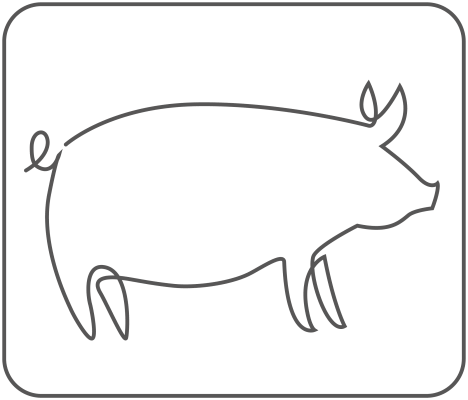TRACE MINERALS
The trace elements (Cu, Fe, Mn, Zn) act as catalysts in enzymatic and hormonal processes. Zinc acts as a co-factor for many enzymes, and has an essential role in cell proliferation, immune functioning, growth and reproduction.
At the same time, zinc is involved in the synthesis of the structural proteins collagen and keratin and protects against oxidative stress. Copper is also involved in a wide range of health and performance-related functions. In addition, an adequate supply of manganese is necessary for bone development, both in embryos and living animals, while iron plays an important role as the central atom of hemoglobin.
THE STABLE CHELAT-COMPOUND
The combination of one of the trace elements with an organic molecule (amino acids/glycine) forms a chelate, which has improved bioavailability in the gastrointestinal tract (GIT) and subsequently in the metabolism. The stable chelate protects the trace element from antagonistic complexes with other feed components in the GIT.
MAXCHELAT is produced in an innovative complexation process and generating a very stable compound within the GIT. In this process, the trace elements (Cu, Fe, Mn, Zn) are complexed with the smallest amino acid glycine in a solid-state reaction process to form an organic compound with a high metal content.
 T1: Improvement of environmental balance in analyzed manure samples of fattening pigs
T1: Improvement of environmental balance in analyzed manure samples of fattening pigs
Trial setup: n = 192; Pi x (DL x DE); 30 – 120 kg weight; Group A: Zn 112ppm, Cu 21ppm; Group B: Zn 43ppm, Cu: 12ppm
Parameter | Group A (Control) | Group B (MAXCHELAT) |
Nitrogen (total) g/kg | 91.6 | 69.0 |
Ammonia g/kg | 61.6 | 37.1 |
P g/kg | 25.4 | 19.5 |
P2O5 g/kg | 58.2 | 44.7 |
Zn mg/kg | 1,371 | 591 |
Cu mg/kg | 1,103 | 423 |
(Source: ISF, 2021)
The high trace element contents of our MAXCHELAT products allow a reduced dietary inclusion rate compared to inorganic trace elements. At the same time, trace element excretion is also minimized because of the greater absorption rate of MAXCHELAT. A study (see table 1) was conducted investigating the effect of feeding diets formulated to meet the requirements on fecal excretions and the zootechnical variables of fattening pigs (n = 192, Pi x (DE x DL)). While the control group was fed inorganic trace element sources (Zn: 112mg/kg, Cu: 21mg/kg diet), the experimental group received a lower trace element content, composed of organic MAXCHELAT Zn and Cu (Zn: 43 mg/kg, Cu: 12 mg/kg diet). The excretion of the trace elements copper and zinc were lower in the experimental group by up to 57% and 62%, respectively, compared to the control group (see table 1). Feeding to the optimum requirement is feasible because of the greater bioavailability of MAXCHELAT. The results demonstrate that a sustainable feeding concept reduces zinc and copper excretion without negative effect on zootechnical variables.

 Deutschland
Deutschland USA
USA Brasil
Brasil Español
Español